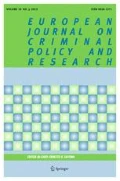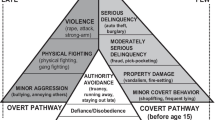Conclusions
Violent and non-violent offending can be predicted more accurately than is generally believed. It is not difficult to identify a high risk category of people at age 8–10 who have an elevated probability (three or four times that of the remainder) of becoming offenders. This identification can be based on either antisocial behaviour or a deprived background or both. Depending on the prevalence of offending, the false positive rates may be high or low, but the odds ratio is a better measure of predictive efficiency. Overall, the early prediction of offending in the Cambridge study was quite impressive.
Similar content being viewed by others
References
Blumstein, A., D.P. Farrington, S. Moitra Delinquency careers: innocents, desisters and persisters. In: M. Tonry, N. Morris (eds.),Crime and Justice: An Annual Review of Research, vol. 6 Chicago, University of Chicago Press, 1985, pp. 187–219
Farrington, D.P. Self-reports of deviant behaviour: predictive and stable?Journal of Criminal Law and Criminology, vol. 64, 1973, pp. 99–110
Farrington, D.P. Predicting self-reported and official delinquency. In: D.P. Farrington, R. Tarling (eds.),Prediction in Criminology Albany N.Y., State University of New York Press, 1985, pp. 150–173
Farrington, D.P. Long-term prediction of offending and other life outcomes. In: H. Wegener et al. (eds.),Criminal Behaviour and the Justice System: Psychological Perspectives New York, Springer-Verlag, 1989a, pp. 26–39
Farrington, D.P. Self-reported and official offending from adolescence to adulthood. In: M.W. Klein (ed.),Cross-National Research in Self-Reported Crime and Delinquency Dordrecht, Kluwer, 1989b, pp. 399–423
Farrington, D.P. Antisocial personality from childhood to adulthoodThe Psychologist, vol. 4, 1991a, pp. 389–394
Farrington, D.P. Childhood aggression and adult violence: early precursors and later life outcomes. In: D.J. Pepler, K.H. Rubin (eds.),The Development and Treatment of Childhood Aggression Hillsdale, NJ, Lawrence Erlbaum, 1991b, pp. 5–29
Farrington, D.P. Juvenile delinquency. In: J.C. Coleman (ed.),The School Years (2nd ed.) London, Routledge, 1992, pp. 123–163
Farrington, D.P. The development of offending and antisocial behaviour from childhood: key findings from the Cambridge study in delinquent developmentJournal of Child Psychology and Psychiatry, vol. 36, 1995, 929–964
Farrington, D.P., R. Loeber Relative improvement over chance (RIOC) and phi as measures of predictive efficiency and strength of association in 2 × 2 tablesJournal of Quantitative Criminology, 5, 1989, pp. 201–213
Farrington, D.P., R. Loeber et al. Self-reported delinquency and a combined delinquency seriousness scale based on boys, mothers and teachers: concurrent and predictive validity for African-Americans and CaucasiansCriminology, 34, 1996, pp. 493–517
Farrington, D.P., R. Tarling Criminological prediction: an introduction. In: D.P. Farrington, R. Tarling (eds.),Prediction in Criminology Albany, NY, State University of New York Press, 1985, pp. 2–33
Farrington, D.P., D.J. West The Cambridge study in delinquent development: a long-term follow-up of 411 London males. In: H.J. Kerner, G. Kaiser (eds.),Kriminalität: Persönlichkeit, Lebensgeschichte und Verhalten Berlin, Springer-Verlag, 1990, pp. 115–138
Fleiss, J.L. Statistical Methods for Rates and Proportions (2nd ed.) New York, Wiley, 1981
Hays, W.L. Statistics New York, Holt, Rinehart & Winston, 1963
Huizinga, D., D.S. Elliott Reassessing the reliability and validity of self-report measuresJournal of Quantitative Criminology, vol. 2, 1986, pp. 293–327
West, D.J. Present Conduct and Future Delinquency London, Heinemann, 1969
West, D.J. Delinquency: Its Roots, Careers and Prospects London, Heinemann, 1982
West, D.J., D.P. Farrington Who Becomes Delinquent? London, Heinemann, 1973
West, D.J., D.P. Farrington The Delinquent Way of Life London, Heinemann, 1977
Author information
Authors and Affiliations
Rights and permissions
About this article
Cite this article
Farrington, D.P. Early prediction of violent and non-violent youthful offending. Eur J Crim Policy Res 5, 51–66 (1997). https://doi.org/10.1007/BF02677607
Issue Date:
DOI: https://doi.org/10.1007/BF02677607




